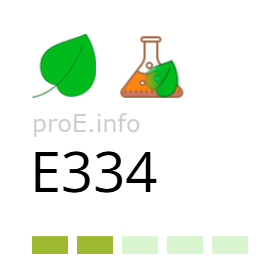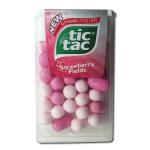
Other names for the additive (synonyms)
General Information
Tartaric acid (food additive E334) is a colorless crystalline substance or white powder without odor and with a very sour taste. In the food industry, it is mainly used as an acidity regulator and antioxidant.
Tartaric acid occurs naturally in many fruits, both in free form and as salts of magnesium, calcium, or potassium.
Chemically, additive E334 is a dicarboxylic hydroxy acid with the formula: C4H6O6.
Tartaric acid exists in three stereoisomeric forms:
- L(+)-tartaric acid – the most common natural form; approved for use in the food industry.
- D(–)-tartaric acid – the mirror image of the L(+) form; rarely found in nature.
- Meso-tartaric acid – a symmetrical form typically produced by chemical synthesis.
For food industry purposes, additive E334 is mostly produced from winemaking by-products (such as wine lees and potassium bitartrate) or from yeast waste. The raw material is dissolved, purified, and crystallized to yield pure tartaric acid in white powder form.
Tartaric acid can also be obtained from fruits or synthetically — by hydrolysis of oxy-polycarboxylic acids or from sugars using chemical reagents. However, these methods are more labor-intensive and less economically efficient.
Effects on the Body
Risks of additive E334
The scientific opinion by the EFSA Panel on Food Additives and Flavourings (FAF) assessed the impact of tartaric acid on human health.
It reported that doses up to 3,100 mg/kg body weight per day in rat studies caused no toxic effects, including nephrotoxicity and carcinogenicity. It also noted that humans absorb less tartaric acid than rats. Genotoxicity and reproductive toxicity were not observed in the studies.
Tartaric acid is a muscle toxin at high doses and can cause paralysis and death. The lethal dose in humans is estimated at 7.5 g/kg of body weight, which would require consuming more than 500 g of tartaric acid in one sitting.
As food additive E334 is used in much smaller amounts in the food industry, the EFSA Committee considers it safe when the acceptable daily intake (ADI) of 240 mg/kg body weight per day (for L(+)-tartaric acid) is respected.
Benefits of additive E334
Some studies have shown that consuming 3–7 glasses of wine per week is associated with a 38–50% lower risk of cardiovascular disease compared to non-drinkers.
Another study found a significant correlation between increased urinary tartaric acid levels and a reduction in inflammatory markers.
Uses
In the food industry, tartaric acid is used as an acidity regulator and antioxidant in the production of canned foods, jams, jellies, and confectionery products.
Additive E334 is also added to beverages and table waters and is widely used in winemaking. It contributes to the tart taste of wine.
Other applications of tartaric acid include:
- In the pharmaceutical industry – for manufacturing soluble drugs and effervescent tablets;
- In cosmetics – in facial and body creams and lotions;
- In the textile industry – for dyeing fabrics;
- In analytical chemistry – for detecting sugars and aldehydes.
Legal Status
Additive E334 is approved for use in food products in Ukraine, the EU, and many other countries.
Tartaric acid is officially recognized as safe and approved for use in the United States without quantitative limits, provided good manufacturing practices (GMP) are followed. According to the FDA, L(+)-tartaric acid is classified as GRAS (Generally Recognized As Safe) and can be used in the food industry.
